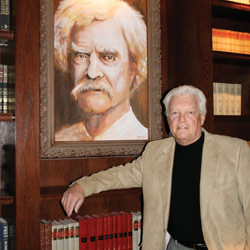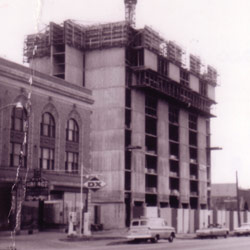
The building that houses the present-day Mark Twain Hotel was originally constructed as a Howard Johnson Motor Lodge in 1968 for $2.5 million. In 1982, after the franchise agreement expired, the hotel went into foreclosure. It reopened as the Concourse Motor Inn, closed again, reopened as the Quality Inn in 1985, and was shuttered yet again the following year.
The property sat vacant for nearly four years, during which time consideration was given to its use as a new Peoria County Jail and as potential housing for the homeless by the Peoria Housing Authority. In 1990, Grieves purchased the property, spent millions in renovations, and opened the new Mark Twain Hotel that October under the Best Western flag. The following year, he purchased and restored the adjacent building, now known as the Packard Plaza.
Congratulations on 20 years of owning and operating the Mark Twain Hotel. What influenced your decision to get into the hotel business?
In 1990, Peoria was in rough shape coming out of the recession, and Caterpillar was struggling. At that time, I was a stockbroker and was always looking for value. The Quality Inn (as it was known then) was repossessed by a Bloomington bank after the previous owner defaulted and was available at a reasonable price. The owner had left town owing two weeks pay to his employees, and the hotel was left in "as-is" condition, which was pretty shabby for about 18 months. During that time, Peoria County nearly purchased the building to make it the county jail! Frankly, I purchased the hotel with every intention of selling once the economy improved, and never dreamed I would own it 20 years later!
How did the Mark Twain get its name?
The Mark Twain is the closest hotel in Peoria to the river, and I have always been associated with the river. Growing up in Lacon, I hunted and fished the river as a boy, and when I was 17, one summer I took a 17' flat-bottom boat on a 1,300-mile journey from Lacon to New Orleans, similar to the Tom Sawyer character in Mark Twain's novel. I was also in the process of buying the Spirit of Peoria at the time, so the name and theme just seemed to make sense!
The Mark Twain and attached restaurant were once part of a franchise. What are the pros and cons of franchising?
We began operating in 1990 as part of the Best Western franchise, and the hotel was known as the Best Western Mark Twain Hotel. We ran our own restaurant called Steamers, and we featured New Orleans-style cooking, which I felt was in keeping with the Mark Twain theme.
In 2001, we changed the restaurant to Pizzeria Uno's, which was a franchise. With a franchise, you get standardization of product and procedures, which is sometimes an advantage, and sometimes not! You pay hefty fees for the name and services rendered. In my early years, I wanted the peace of mind that comes with a franchise, but later, as I understood the business better, I found the red tape and fees excessive.
A hotel franchise may command as much as eight to 10 percent of gross revenues when all the fees are added up. For a hotel our size, this amounted to sending over $250,000 out of town. Instead, I chose to invest that money in keeping our hotel up to date and our employees well paid so they deliver superior service to our guests. I took the same approach with our restaurant, converting it a couple of years ago to an upscale restaurant run by three local entrepreneurs and called Two25. It has been an outstanding success, and I am very proud of them and what they have accomplished.
What type of guests frequent the hotel?
We are primarily a business hotel, but also get our share of the leisure market—particularly weddings that are held at our sister property, the Packard Plaza. Our business clients are professional, demanding and appreciative of the extra mile our staff goes for them to make the Mark Twain their home away from home. I would say that our typical business guest is a seasoned traveler who appreciates staying someplace that doesn't feel like a chain!
What does a small boutique hotel need to offer to compete with a larger chain?
The large chains have the advantage of very deep pockets, national exposure, name recognition, loyalty programs and massive advertising budgets. Small, independent hotels have none of these things; in fact, when I travel to a strange city, I may not take a chance on a Mark Twain Hotel because it could be a pleasant surprise or a major disappointment.
We rely on word of mouth and recommendations from our existing customers—so we have to be good, or we die quickly. We have an enormous advantage over larger chains in that we can adapt to customer needs very quickly and do not have to go through layers of bureaucracy to get something done. Our advertising is mostly local and because much of our business comes from Peoria-area businesses recommending us, I feel it is important to stay "top of mind" with them.

I think people are growing tired of hotel chains and restaurants that all seem alike, and they are looking for something fresh and different. We offer rooms with state-of-the-art technology, customized furniture that is built locally, special mattresses that are made locally, and our restaurant is run by local people. In short, we are a local hotel, run by people who have made Peoria their home for most of their lives. We have a staff (many who have been with us for years) that truly understand what guest service is all about, and I am quite proud of them. Watching the Mark Twain Hotel evolve over the years has been a great pleasure for me.
How did the Packard Plaza get its start?
The Packard building has quite a history. It was built sometime prior to 1885, and the original building was a bathhouse where artesian baths were available. It was razed in 1926, rebuilt and named the National Building. The lower level and basement was home to a Packard [automobile] dealership, while the upper floor was occupied by a 16-lane bowling alley and billiard parlor, which at the time was the largest bowling alley between Chicago and St. Louis.
It was the rooftop, however, that brought the building widespread fame. In 1931, the National Roof Garden opened, which soon became the largest open-air roof garden devoted to dancing in the area. Guy Lombardo, Artie Shaw and Lawrence Welk were just some of the great performers that played the rooftop during the summer months. To this day, I still have people tell me they have fond memories of dancing there.
I purchased the building in 1990 from Peoria County, who had been using it for storage. At the time, Diane Cullinan was building Hamilton Square, and the County was considering demolishing the building to make way for the development. The Central Illinois Landmarks Foundation was fighting to preserve the building as a city landmark because it was designed by architect Frederick Klein and it contained the very unique terra cotta arches that grace the front of the building. In the end, the rear 70 feet of the building was removed to square off the Hamilton Square building and parking deck, and I stepped in and purchased a three-sided building. iBi

